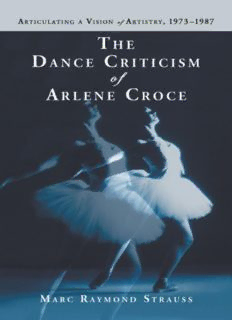
The Dance Criticism of Arlene Croce: Articulating a Vision of Artistry, 1973-1987 PDF
Preview The Dance Criticism of Arlene Croce: Articulating a Vision of Artistry, 1973-1987
The Dance Criticism of Arlene Croce ALSOBYMARCRAYMONDSTRAUSS Alfred Hitchcock’s Silent Films (McFarland, 2004) The Dance Criticism of Arlene Croce Articulating a Vision of Artistry, ¡973–¡987 MARC RAYMOND STRAUSS McFarland & Company, Inc., Publishers Jefferson, North Carolina, and London Essays by Arlene Croce that appear herein were originally published in The New Yorkerand are used by permission. LIBRARYOFCONGRESSCATALOGUING-IN-PUBLICATIONDATA Strauss, Marc. The dance criticism of Arlene Croce : articulating a vision of artistry, ¡973–¡987 / Marc Raymond Strauss. p. cm. Includes bibliographical references and index. ISBN 0-7864-2350-¡(softcover : 50# alkaline paper) ¡. Croce, Arlene—Criticism and interpretation. 2. Dance critics. 3. Dance criticism. 4. New Yorker (New York, N.Y. : ¡925) I. Title. GV¡785.C76S87 2005 792.8—dc22 2005022639 British Library cataloguing data are available ©2005 Marc Raymond Strauss. All rights reserved No part of this book may be reproduced or transmitted in any form or by any means, electronic or mechanical, including photocopying or recording, or by any information storage and retrieval system, without permission in writing from the publisher. Front coverphotograph ©2005 SuperStock Manufactured in the United States of America McFarland & Company, Inc., Publishers Box 6¡¡, Je›erson, North Carolina 28640 www.mcfarlandpub.com To the memory of my brother, Daniel Armand Strauss Acknowledgments I want to thank all the dedicated scholars over whose texts I have pored for this study and from whom I hope I have absorbed some frac- tion of their generous spirit and sense of true criticism. Critics often get a bad name—and rightly so, if they exist just to find fault and to disap- prove. I hope this reveals something about the craft of the true critic: “a person who [analyzes, interprets, and] judges the merits of literary, artistic, or musical works, especially one who does so professionally” (The New Oxford American Dictionary, 200¡, p. 405). I also want to thank everyone who helped this manuscript see the light of day. Meta-criticism (the act of criticizing criticism) is a very young field. Perhaps, through this unique thought process, dance can inspire critical traditions in ways that will be of benefit to other art forms—music, theatre, and particularly the visual arts, with their long and rich history of analysis. Essays and excerpts by Arlene Croce that are reprinted in this book were originally published in The New Yorker. vii Table of Contents Acknowledgments vii Preface xi Introduction 1 1. Historical Foundations 11 Essay: “Jo›rey Jazz” 17 2. Arlene Croce’s Professional Heritage 24 Essay: “Momentous” 34 3. The New Yorker 40 Essay: “What You See Is What You Get” 47 4. The Ethics of Dance Criticism 52 Essay: “The Mercists” 62 5. Theoretical Models from Literary Analysis 67 Essay: “Think Punk” 88 6. Croce’s Use of Rhetorical Devices 94 Essay: “So Rare” 100 7. Croce-as-Audience and Croce-as-Critic 105 Essay: “Paging Mr. Astaire” 117 8. Arlene Croce’s Aesthetic Framework 124 Essay: “Mark Morris Comes to Town” 144 ix
Description: